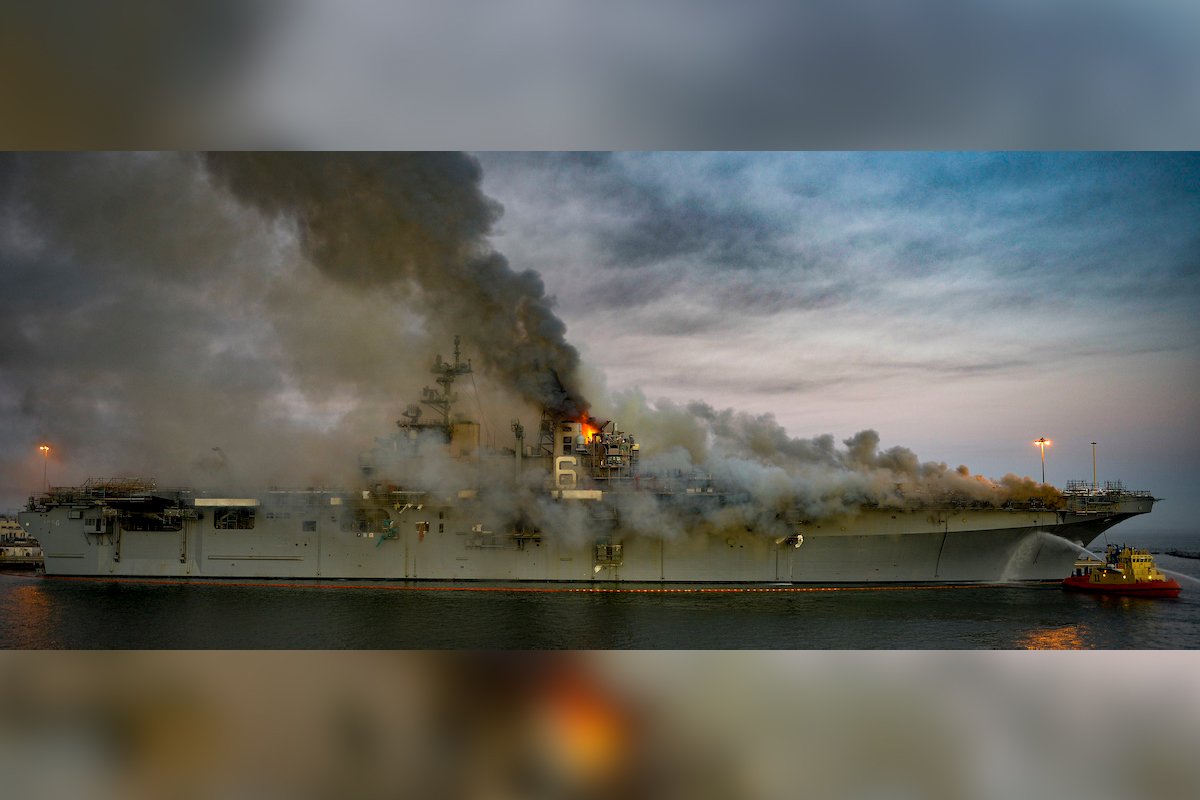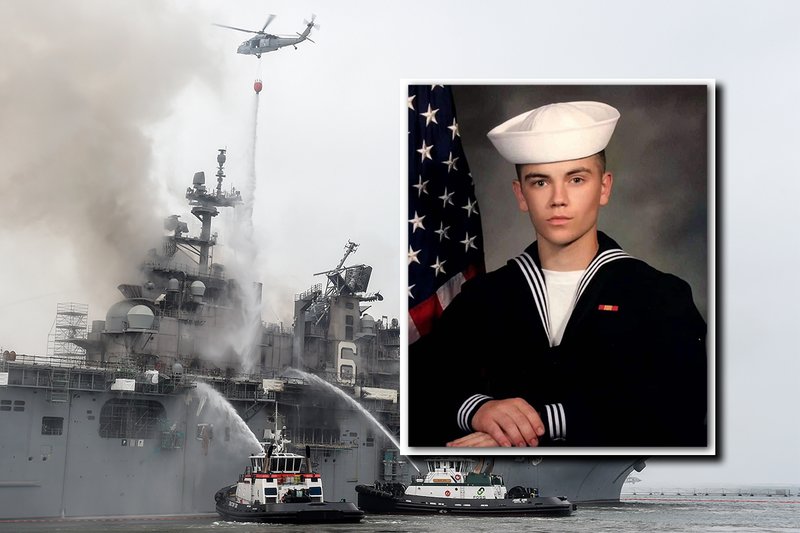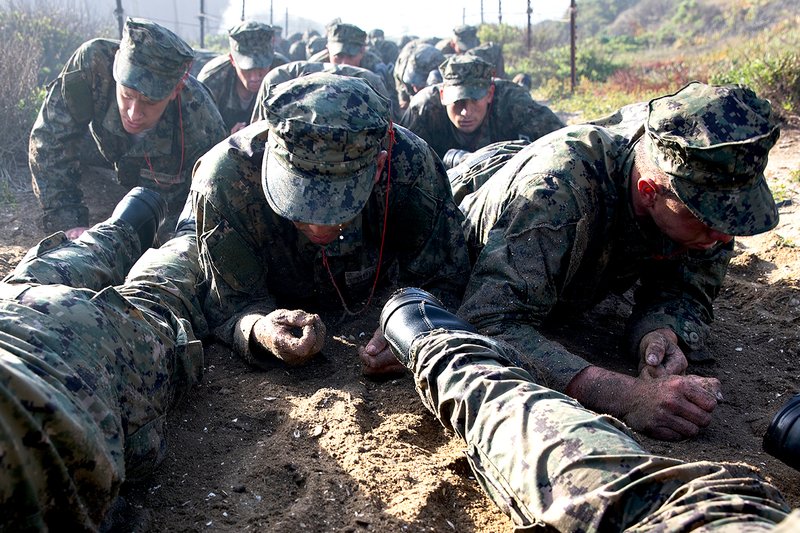Sailor Accused in Warship Fire Falsely Claimed 2 SEAL Hell Weeks, Investigator Says

The USS Bonhomme Richard burns in San Diego in July 2020. Ryan Sawyer Mays was formally charged in December 2021 with starting the fire on the warship. US Navy photo.
SAN DIEGO — A federal agent investigating the Bonhomme Richard fire testified Tuesday, Sept. 20, that the sailor accused of setting the blaze, Ryan Sawyer Mays, falsely claimed during a tour of the ship to have trained in two Navy SEAL Hell Weeks, the infamous training event that keeps would-be SEALs awake and training for five days.
In fact, Mays dropped out of SEAL training in the first week of the course, never reaching a Hell Week, according to the Navy. He was subsequently assigned to the Bonhomme Richard as it underwent repairs. There, he set a fire out of a sense of disgruntlement with his lowly job on board an inactive ship, prosecutors said.
Mays is facing a court-martial this week in San Diego. In testimony Tuesday, Special Agent Matthew Beals of the Bureau of Alcohol, Tobacco, Firearms and Explosives said that, in the weeks after the fire, investigators had combed the ship for clues. They were with Mays on one visit to the ship, and he pointed out to them where he said he had been that night, Beals testified.

Ryan Sawyer Mays, 20, is accused of arson in the July 12, 2020, fire that consumed the USS Bonhomme Richard. Photos from GoFundMe, US Navy. Composite by Coffee or Die Magazine.
At one point, the group stood on the flight deck of the ship, taking in the view around San Diego bay, including the SEALs' training compound.
“What did Seaman Mays tell you on the ship?" Capt. Jason Jones, the Navy's lead prosecutor, asked Beals.
“[Mays] told me he went to Hell Week twice,” Beals replied.
“And what could you see from the flight deck when Mays asked this?” Jones followed up.
“The BUD/S O Course,” Beals said, referring to the obstacle course at the SEALs’ training center.
The exchange was an example of Mays lying to investigators, prosecutors said.

SEAL candidates crawl through the mud during Hell Week. US Navy photo by Petty Officer 1st Class Abe McNatt.
While the exchange with Beals was the prosecution's only attempt to establish a motive for Mays, prosecutors spent much of the rest of the day asking technical experts to explain how the fire started — and how it probably did not — on board the Bonhomme Richard in July 2020.
Prosecutors began by calling a Naval Criminal Investigative Service, or NCIS, agent. Special Agent Garrett Radke created a 3D computer model of the ship's lower vehicle stowage area, or lower V, in early September 2020, allowing investigators to model the origin and spread of the fire.
After Radke, the remainder of the court’s day went to Beals, a certified fire investigator with the ATF. Beals said he believed the fire was caused by an open flame applied to an ignitable liquid on cardboard containers in the Lower V.
During cross-examination, Mays’ attorney Lt. Cmdr. Jordi Torres questioned Beals on whether he had discarded alternative causes too hastily, including the possibility that nearby lithium-ion batteries could have provided the initial spark. Beals described tests that investigators had run on the lithium-ion batteries found in the lower V, but he said that he ultimately discarded the possibility that the batteries could have caused the fire.
Editor's Note: This story has been updated to reflect ATF agent Matthew Beals' testimony that Ryan Sawyer Mays claimed to have trained in two Hell Weeks, but did not indicate in his testimony whether Mays claimed to have completed the training.
Read Next: Air Force ‘Flips,’ Says Special Ops, Recruiters, and Others Won’t Face Pay Cuts

Tom Wyatt was a SkillBridge intern for Coffee or Die. He is an active-duty Naval Special Warfare boat operator and a proud father living in San Diego, California. Tom is a budding reporter, looking to pursue journalism and fiction writing upon exiting the Navy.
BRCC and Bad Moon Print Press team up for an exclusive, limited-edition T-shirt design!
BRCC partners with Team Room Design for an exclusive T-shirt release!
Thirty Seconds Out has partnered with BRCC for an exclusive shirt design invoking the God of Winter.
Lucas O'Hara of Grizzly Forge has teamed up with BRCC for a badass, exclusive Shirt Club T-shirt design featuring his most popular knife and tiomahawk.
Coffee or Die sits down with one of the graphic designers behind Black Rifle Coffee's signature look and vibe.
Biden will award the Medal of Honor to a Vietnam War Army helicopter pilot who risked his life to save a reconnaissance team from almost certain death.
Ever wonder how much Jack Mandaville would f*ck sh*t up if he went back in time? The American Revolution didn't even see him coming.
A nearly 200-year-old West Point time capsule that at first appeared to yield little more than dust contains hidden treasure, the US Military Academy said.












